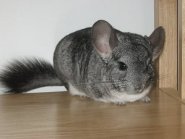Tuesday 19 May 2015 Chinchilla - Magnificent Fur Blessing and Curse
 In the unforgiving, wind-swept Andes Mountains of South America, a fur coat so thick that it repels water is a blessing. Long-tailed chinchillas (Chinchilla lanigera) are blessed with such a plush coat. But that same coat is the cause of their critically endangered status in the wild. They have been hunted so ruthlessly for their fur that they are nearly extinct in the wild. Fortunately, they survive well in captivity and make excellent pets.
In the unforgiving, wind-swept Andes Mountains of South America, a fur coat so thick that it repels water is a blessing. Long-tailed chinchillas (Chinchilla lanigera) are blessed with such a plush coat. But that same coat is the cause of their critically endangered status in the wild. They have been hunted so ruthlessly for their fur that they are nearly extinct in the wild. Fortunately, they survive well in captivity and make excellent pets.General Appearance
Long-tailed chinchillas, also called Chilean chinchillas or “chins” by pet owners, are rodents more closely related to guinea pigs than to mice. Their foot long (30.48 cm) bodies are very round with comparatively tiny feet and a long, silky tail an additional 5 to 6 inches (12.7 to 15.2 cm) long. Their heads are more rabbit-like than guinea pig-like with pleasantly prominent ears that are rounded at the tips. Despite their chubby appearance, the largest chins only weigh 2 pounds (0.91 kg.)
Wild chinchillas sport the same color of fur – a silver grey with pale bellies. But domesticated chinchillas come in a variety of colors, including albino, white (with dark eyes) beige, shades of black and a brown-grey shade called lavender. Chinchillas must bathe in dust because the coat takes such a long time to dry that the animal could catch pneumonia. In the Andes Mountains, rain is rare and so the animals evolved to not rely on it.
Behavior
In the wild, chinchillas live in small colonies and eat grass, lichens, seeds and occasionally dead insects. Like any other rodent, chinchilla’s front teeth grow continuously throughout their lives in order to accommodate for their hard diet. In captivity, chinchillas need to eat hard foods and be given chew toys so their teeth do not grow too long.
After a gestation of around 112 days, chinchilla babies are born fully furred with their eyes open and their teeth grown in. They can soon walk after birth and follow after their parents. Both parents help in their care, but the mother winds up doing most of the work. Babies are weaned when they are two months old. They become sexually mature by the time they are eight months old. Living in small colonies means that there are many eyes working together to look out for predators. The chinchilla’s main form of defense is their speed. Despite their comical appearances, chinchillas can sprint in amazingly quick bursts of speed. They rarely run in a straight line but zig-zag and leap to out-maneuver natural predators such as birds of prey.
The Chinchilla Today
Long-tailed chinchillas are one of the rarest mammals to be found in the Andean mountains. Hunting them became outlawed by 1918, although poaching does occur. In the early 1900s, 12 chinchillas, nine males and three females, were brought to the United States by an ex-miner named Matthias F. Chapman. All pet chinchillas in North America are descended from 11 of these 12. One chinchilla turned out to be too old to breed. There are chinchilla farms in many countries of the world where these gentle, friendly animals are killed for their pelts.
Chinchillas are remarkably long-lived for rodents. Those in captivity have lived as long as 20 years, although the world record holder lived a whopping 26 years. In the wild, their lifespans are considerably shorter but animals living to 15 have been recorded. You can help spreading the word about this animal by liking it on facebook
